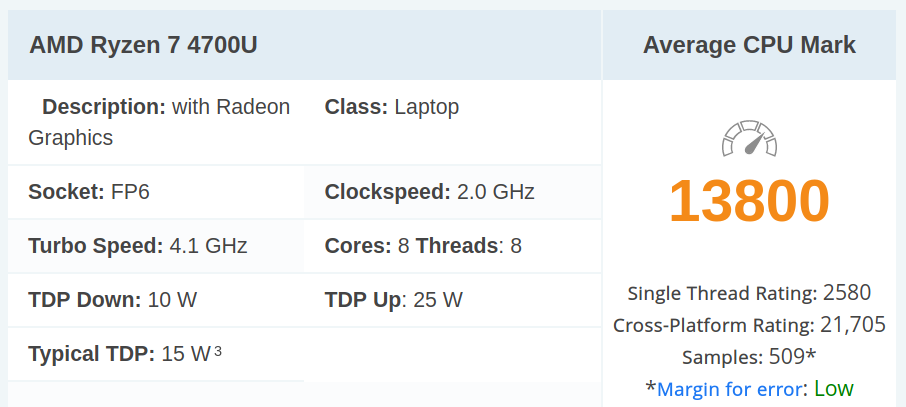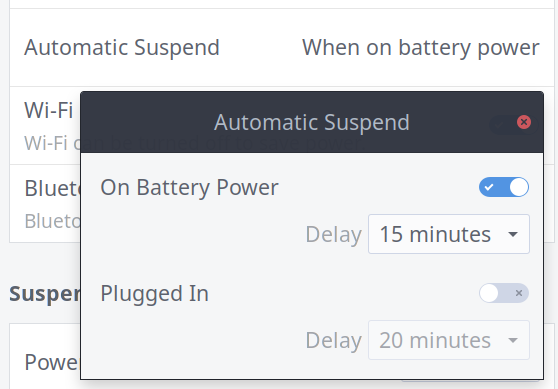

In 2021 its very hard to find a laptop under £1000 with a decent screen. Most have 45% NTSC Colour Gamut. Most reviews will tell you this is ok as long as you are not gaming or photo editing. It is NOT ok. At 45% NTSC colours are washed out. Especially the red. This is noticable even just browsing the web, let alone looking at photos. A 45% NTSC screen is just not good enough, yet this is what most laptops come with. The minimum for a usable laptop is 72% NTSC or 100% sRGB.
Laptop hinges are another area which can be difficult. Most laptops now come with a hinge that uses the lid/screen to prop the body off the ground. The reasoning behind this is that it creates a gap between the laptop and desk for airflow because modern laptops get so hot. This is no good if you are actually using the laptop on your lap. Also the jury is out on the reliability and durability of these hinges. The Lenovo has a traditional hinge and little feet that keep the case off the desk. That said it does not seem to get hot under normal operation.

Ports are another issue on laptops. Its hard to find one with a decent array of ports. Trackpads are usually awful so first thing I do is plug a USB mouse in, thats one port gone straight away. The Lenovo has a decent amount of ports.

Like all machines now, the laptop comes with Windows pre-installed and a recovery partition and no CD/DVDs. I have no plns to use Windows at all, so I backed up the whole disk via dd to a file image on a spare USB hard drive. I then installed Ubuntu Budgie 20.10 using full disk encryption and the whole hard drive.
Disk /dev/nvme0n1: 476.94 GiB, 512110190592 bytes, 1000215216 sectors Disk model: SAMSUNG MZVLB512HBJQ-000L2 Units: sectors of 1 * 512 = 512 bytes Sector size (logical/physical): 512 bytes / 512 bytes I/O size (minimum/optimal): 512 bytes / 512 bytes Disklabel type: gpt Disk identifier: 885501F8-62CB-459A-86D0-A69CBBB64903 Device Start End Sectors Size Type /dev/nvme0n1p1 2048 1050623 1048576 512M EFI System /dev/nvme0n1p2 1050624 2549759 1499136 732M Linux filesystem /dev/nvme0n1p3 2549760 1000214527 997664768 475G Linux filesystem
Linux is installed in an encrypted partion which contains two LVMs, one for swap and one for root.
nvme0n1 │ ├─nvme0n1p1 │ vfat FAT32 44BA-16B5 /boot/efi ├─nvme0n1p2 │ ext4 1.0 5e7309a6-6f5b-44e3-aff7-e92b969bdb97 /boot ├─nvme0n1p3 │ crypto 2 b6a7071a-e553-4e95-9544-9dc9ddcfed61 │ └─nvme0n1p3_crypt │ LVM2_m LVM2 T25pQf-qlNw-pwNV-5dvg-xOTO-KoKG-tW3CjD │ ├─vgubuntu--budgie-swap_1 │ │ swap 1 b02b828e-f0bf-4ecb-910a-b88392056049 [SWAP] │ └─vgubuntu--budgie-root │ ext4 1.0 108f19e8-9b45-48b1-9eb6-d20fd8f011d4 /
There are two issues with the above layout. Ubuntu only installs 1GB of swap, which is not enough if S4 Hibernate is required. Also I am not keen on everything being in one large root partition.
See separate disk encryption notes...
There are two issues with the above layout. Ubuntu only installs 1GB of swap, which is not enough if S4 Hibernate is required. Also I am not keen on everything being in one large root partition.
The first task is to mount and backup the root filesystem. To do this we use a spare USB drive with atleast 30GB of free space, and boot from an Ubuntu Live USB stick.
Mount the encrypted volume:
root@ubuntu-budgie:~# cryptsetup open /dev/nvme0n1p3 linux Enter passphrase for /dev/nvme0n1p3:
Scan for volume groups:
root@ubuntu-budgie:~# vgscan Found volume group "vgubuntu-budgie" using metadata type lvm2 root@ubuntu-budgie:~# vgchange -ay 2 logical volume(s) in volume group "vgubuntu-budgie" now active
Scan for volume groups and logical volumes:
root@ubuntu-budgie:~# lvscan ACTIVE '/dev/vgubuntu-budgie/swap_1' [980.00 MiB] inherit ACTIVE '/dev/vgubuntu-budgie/root' [473.00 GiB] inherit
Mount the root partition:
root@ubuntu-budgie:~# mkdir /media/root root@ubuntu-budgie:~# mount /dev/vgubuntu-budgie/root /media/root
Mount a USB drive with atleast 30GB of space:
root@ubuntu-budgie:~# cd /media/data root@ubuntu-budgie:/media/data# mkdir BACKUP
Backup / to the USB drive:
root@ubuntu-budgie:/media/data# cd BACKUP root@ubuntu-budgie:/media/data/BACKUP# cp -a /media/root/. .
Unmount the root filesystem:
umount /media/root
The next step is DESCRUCTIVE. It will delete the Linux installation. All data will be LOST. Only do this on a new install, if you know what you are doing, and if you have backed up the data following the steps above!
Delete the logical volumes:
lvremove /dev/vgubuntu-budgie/swap_1 lvremove /dev/vgubuntu-budgie/root
Note at this stage if you only want to increase swap, at the expense of the root volume there is no need to change the disk partition and volume group. You can skip straight to recreating the logical volumes. LINK here STEVE.
Delete the logical volumes:
cryptsetup remove /dev/mapper/linux
Change the size of the /dev/nvme0n1p3 partion using your favourite disk utility tool:
fdisk /dev/nvme0n1
Create smaller partition /dev/nvme0n1p3. I shrunk it to 75GB and created a new 400GB /dev/nvme0n1p4 which will be an encrypted LUKS volume and hold all my data.
Device Start End Sectors Size Type /dev/nvme0n1p1 2048 1050623 1048576 512M EFI System /dev/nvme0n1p2 1050624 2549759 1499136 732M Linux filesystem /dev/nvme0n1p3 2549760 159836159 157286400 75G Linux filesystem /dev/nvme0n1p4 159836160 1000214527 840378368 400.7G <--New partion to hold data
Create an encrypted volume on the 75GB /dev/nvme0n1p3 partition:
cryptsetup -y -v luksFormat /dev/nvme0n1p3 cryptsetup open /dev/sda3 linux
Create physical and logical volumes:
pvcreate /dev/mapper/linux vgcreate vgubuntu-budgie /dev/mapper/linux
Create two logical volumes in the 75GB partition. I used 9GB to match the memory, use smaller if you do not need to hubernate.
lvcreate -L 9G vgubuntu-budgie -n swap_1 lvcreate -l 100%FREE vgubuntu-budgie -n root
Create the filesystems on the two new logical volumes:
mkswap /dev/vgubuntu-budgie/swap_1 mkfs.ext4 /dev/vgubuntu-budgie/root
The layout should look something like this now:
lsblk --fs ├─nvme0n1p3 crypto 2 b6a7071a-e553-4e95-9544-9dc9ddcfed61 │ └─linux │ LVM2_m LVM2 T25pQf-qlNw-pwNV-5dvg-xOTO-KoKG-tW3CjD │ ├─vgubuntu--budgie-swap_1 │ │ swap 1 b02b828e-f0bf-4ecb-910a-b88392056049 │ └─vgubuntu--budgie-root │ ext4 1.0 108f19e8-9b45-48b1-9eb6-d20fd8f011d4
Mount the newly created empty root partition:
mount /dev/vgubuntu-budgie/root /media/root
Copy back the root filesystem from the USB backup created earlier:
cd /media/root cp -a /media/data/BACKUP/* .
Next we need to adjust the luksUUID of /dev/nvme0n1p3 to match what was in /etc/crypttab:
cat /media/root/etc/crypttab nvme0n1p3_crypt UUID=6b1a9ade-99a7-4778-baf0-106bd2f21254 none luks,discard
Change the luksUUID of /dev/nvme0n1p3 to match the output above:
cryptsetup luksUUID /dev/nvme0n1p3 --uuid "6b1a9ade-99a7-4778-baf0-106bd2f21254"
Now reboot and the new disk layout should be effective!
Use the following command to see which suspend modes are supported:
dmesg | grep ACPI:\ \( [ 0.341638] ACPI: (supports S0 S4 S5)
The laptop does not support S3 Suspend. When it goes into suspend it actually uses S0, s2idle, which uses quite a bit of power.
Hibernate will save the RAM to swap (disk), and power down the machine completely. Note to support Hibernate Secure Boot has to be disabled.
Use the following command to test Hibernate:
systemctl hibernate
To check the logs:
sudo journalctl | grep -Ei "PM: |hibernation"
To change the laptop to hibernate when the lid is closed edit the login.conf file:
/etc/systemd/login.conf HandleLidSwitch=hibernate
Change the GRUB config to resume from the swap partion:
/etc/default/grub GRUB_CMDLINE_LINUX_DEFAULT="quiet splash resume=/dev/mapper/vgubuntu--budgie-swap_1"
Update grub:
sudo update-initramfs -u -k all sudo update-grub
I have found the lid switch on the Lenovo pretty sensitive. This means even if you catch the lid it will boot the laptop. I tried a few Linux option to disable booting when the laptop starts:
None of these worked for me.
What did work for me was disabling "Flip to Boot" in the laptop BIOS.
We still have the problem that after 15 minutes in Ubuntu Budgie that the laptop will suspend (to S0) and not hibernate.

If we disable AllowSuspend in sleep.conf the option will disappear completely. I ofen wander away from my latop, so would like some sort of suspend/hibernate. To work around this I changed the definition of suspend to be hibernate:
/etc/systemd/sleep.conf AllowHybridSleep=no AllowHibernation=yes SuspendMode=platform shutdown SuspendState=disk
There is probably a better way of doing this, but it works for me.
Turns out there is. Set this with Dconf Editor:
org.cinnamon.settings-daemon.plugins.power sleep-inactive-battery-type 'hibernate'
Initially it would fail to wake from hibernate due to a graphics issue:
WARNING: CPU: 4 PID: 10460 at drivers/gpu/drm/amd/amdgpu/../display/dc/core/dc_link.c:2546 dc_link_set_backlight_level+0x92/0xf0 [amdgpu] ... Feb 09 14:57:01 stealth kernel: amdgpu 0000:03:00.0: [drm:amdgpu_ring_test_helper [amdgpu]] *ERROR* ring kiq_2.1.0 test failed (-110) Feb 09 14:57:01 stealth kernel: [drm:amdgpu_gfx_enable_kcq.cold [amdgpu]] *ERROR* KCQ enable failed Feb 09 14:57:01 stealth kernel: [drm:amdgpu_device_ip_resume_phase2 [amdgpu]] *ERROR* resume of IP blockfailed -110 Feb 09 14:57:01 stealth kernel: [drm:amdgpu_device_resume [amdgpu]] *ERROR* amdgpu_device_ip_resume failed (-110). Feb 09 14:57:01 stealth kernel: PM: dpm_run_callback(): pci_pm_restore+0x0/0xf0 returns -110 Feb 09 14:57:01 stealth kernel: PM: Device 0000:03:00.0 failed to restore async: error -110
For more inflormation see here. But since a kernel update all seems ok now.
To suit my requirements I removed these packages and installed my usual software.
Remove packages:
apt remove rhythmbox apt remove gnome-2048 apt remove aisleriot apt remove gnome-mines apt remove gnome-sudoku
Add packages:
apt install gnome-terminal apt install net-tools apt install python3-pip apt install geany (problem with geany freezing when typing) apt install handbrake apt install clementine apt install openssh-server apt install python3-acoustid apt install php-getid3 apt install flac apt install lame apt install inkscape apt install pdfjam apt install php-cli apt install sigil apt install evince apt install audacity apt install mediainfo apt install mkvtoolnix-gui apt install rclone apt install libgl1-mesa-glx apt install syslinux-utils apt install librsvg2-bin apt install exiftool apt install gpsbabel apt install php-xml apt install mediainfo-gui apt install isync
Add other packages:
XnViewMP-linux-x64.deb Signal Puddletag
